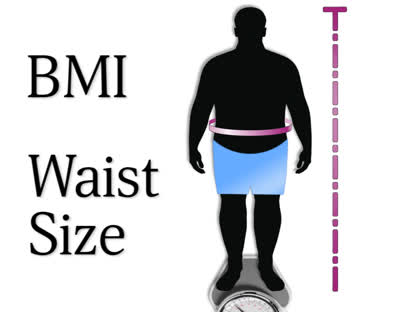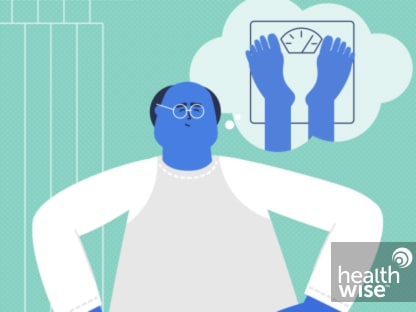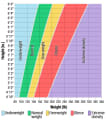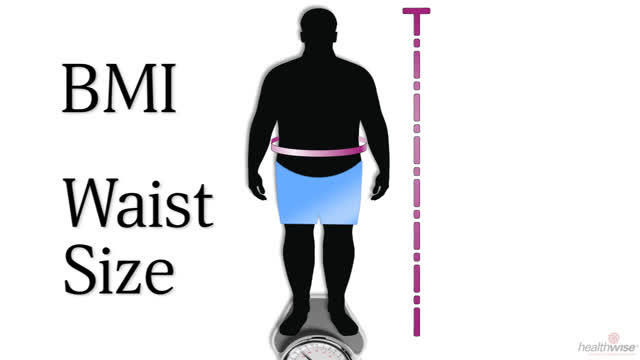Weight Management
Overview
What is a healthy weight?
A weight that's healthy for you is one that lowers your risk for health problems related to weight. For most people, this means having a body mass index (BMI) from 18.5 to 24.9. BMI is a number based on a person's weight and height.
Why pay attention to your weight?
Staying at a weight that's healthy for you is one of the best things you can do for your health. It can help prevent serious health problems, including heart disease, stroke, and type 2 diabetes. It also makes it easier to be active and have plenty of energy to do the things you enjoy.
What can you do to get to a healthy weight and stay there?
If you want to get to a weight that's healthy for you and stay there, it's important to make healthy lifestyle changes. These steps can help.
- Eat healthy foods. Try to eat a variety of food every day. These include whole grains, vegetables, fruits, dairy products, and lean protein foods. All foods, if eaten in moderation, can be part of healthy eating.
- Be active. When you're active, you burn calories. This makes it easier to reach and stay at a weight that's healthy for you. Try to do at least 2½ hours of moderate activity or 1¼ hours of vigorous activity each week.
- Change your thinking. When you're trying to reach a weight that's healthy for you, changing how you think about certain things may help. Here are some ideas:
- Don't compare yourself to others. Healthy bodies come in all shapes and sizes.
- Pay attention to how hungry or full you feel.
- Focus on improving your health instead of dieting.
Are You at a Healthy Weight?
Find out your body mass index (BMI)
Body mass index (BMI) can help you see if your weight is raising your risk for health problems. It uses a formula to compare how much you weigh with how tall you are.
- A BMI lower than 18.5 is considered underweight.
- A BMI between 18.5 and 24.9 is considered healthy.
- A BMI between 25 and 29.9 is considered overweight. A BMI of 30 or higher is considered obese.
If your BMI is in the normal range, it means that you have a lower risk for weight-related health problems. If your BMI is in the overweight or obese range, you may be at increased risk for weight-related health problems, such as high blood pressure, heart disease, stroke, arthritis or joint pain, and diabetes. If your BMI is in the underweight range, you may be at increased risk for health problems such as fatigue, lower protection (immunity) against illness, muscle loss, bone loss, hair loss, and hormone problems.
BMI is just one measure of your risk for weight-related health problems. You may be at higher risk for health problems if you are not active, you eat an unhealthy diet, or you drink too much alcohol or use tobacco products.
Measure your waist size
Waist circumference is the distance around your waist. Measuring it is a way to check how much fat is on your belly. Having extra belly fat increases your risk of health problems such as heart disease and diabetes.
For most people, the goal for a healthy waist is:
- Less than 40 in. (102 cm) for men.
- Less than 35 in. (88 cm) for women.
People who are "apple-shaped" and store fat around their belly are more likely to develop weight-related diseases than people who are "pear-shaped" and store most of their fat around their hips.
To find your waist circumference, use a tape measure to measure around your body at the top of your hipbone. This is usually at the level of your belly button. The tape should fit snugly but not press into your skin.
Check how much body fat you have
Body fat testing checks how much body fat you have. It may be done to find out if you have too much or too little body fat.
The test is one of the ways to measure healthy weight.
People who are trying to become more fit and lose weight sometimes use the test to check for changes in their body fat levels.
Experts have different opinions about what is a healthy body fat range. Body fat recommendations are based on a person's age, sex, and activity level.
Learn more
Watch
What Affects Your Weight?
When you take in more calories than you burn off, you gain weight. How you eat, how active you are, and other things affect how your body uses calories and whether you gain weight.
If you have family members who have too much body fat, you may have inherited a tendency to gain weight. And your family also helps form your eating and lifestyle habits, which can lead to obesity.
Also, our busy lives make it harder to plan and cook healthy meals. For many of us, it's easier to reach for prepared foods, go out to eat, or go to the drive-through. But these foods are often high in saturated fat and calories. Portions are often too large.
Your genes
Genes determine what features (genetic traits) you inherit from your parents. They influence your weight by their effect on:
- How your body uses calories (energy metabolism).Some people need fewer calories to fuel their bodies. They may have "leftover" calories that are stored as fat. Other people need more calories to fuel their bodies. They have fewer leftover calories to store as fat.
- Basal metabolic rate (BMR).BMR is how much energy you burn when you're at rest. If you have a lower BMR, it's easier to gain weight.
- Body signals.Hunger, fullness (satiety), food cravings, and appetite are body signals that tell you how much to eat.
- Set point.Your body may try to keep your weight within a specific range, or set point.
- Fat distribution.Some people tend to store fat in their belly. Some people store more fat in their hips and thighs.
Calories from the foods you eat
Food gives your body energy. Energy from the food you eat is measured in calories. This energy keeps your heart beating, your brain active, and your muscles working.
Your body needs a certain number of calories each day. After your body uses the calories it needs, it stores extra calories as fat.
To lose weight safely, you have to eat fewer calories while eating in a healthy way.
How active you are
Being active is one of the best things you can do to get fit and stay healthy. It helps you feel stronger and have more energy. It can help you lose fat, build muscle, and reach a weight that's healthy for you. Being active may also help you feel better, sleep better, and focus.
Learn more
How Can You Get to a Healthy Weight?
Make a plan
If you want to get to a weight that's healthy for you, making healthy lifestyle changes will probably work better than dieting. In the long run, diets don't work for most people. Try these steps.
- Make a plan for change. Your doctor can help you create a plan that's right for you. This includes setting a weight loss goal. For most people, a goal of losing 5% to 10% of their weight is a good place to start. Your plan will also include small changes you can make in your nutrition, eating habits, and physical activity.
- Try to be more active. Make physical activity a part of your daily life. Start slowly if you haven't been active.
- Try tracking your food and activity. Keeping track of what you eat, your activity, and your weight can help you succeed with your plan. There are free apps that make tracking easy.
- See a dietitian. A dietitian can show you how to make long-term healthy changes in your eating habits.
- Try to manage stress. Having a lot of stress in your life can make it hard to focus on making healthy changes to your daily habits.
Set goals
So you're ready to set goals to get to a weight that's healthy for you. That's great!
- Focus on small goals. For example, your large goal may be to lose 50 lb (22.7 kg). Your small goal could be to lose 5 lb (2.3 kg).
- Write down your goals. This will help you remember, and you'll have a clearer idea of what you want to achieve.
- Make your goals specific. For example, setting a goal to eat 5 helpings of fruits and vegetables 5 days a week is better than a general goal to "eat more vegetables."
- Focus on one goal at a time. You're less likely to feel overwhelmed and then give up.
- When you reach a goal, reward yourself. Celebrate your new behavior and success for several days, and then think about setting your next goal.
Change the way you think about weight
Our thoughts have a lot to do with how we feel and what we do. If you need to make changes to get to a weight that's healthy for you, you may find it helpful to start paying attention to how you think about weight and what kinds of things you tell yourself about your weight.
When you shift your thinking to become more positive and helpful, you may be surprised at how much better you feel about your goals and your ability to achieve them. Here are some things to remember:
- Healthy bodies come in all shapes and sizes.
- Food is neutral. It's not "good" or "bad," and you aren't "good" or "bad" depending on what you eat.
- You aren't a number on a scale.
With time and practice, you can change what you say to yourself. You can learn to think in a healthy way even when you have setbacks.
Keep track of your weight
Keep track of your weight. Tracking your weight can help you see how you're doing. It can inspire you to keep going and help you make a plan to avoid slip-ups.
- Try to weigh yourself on the same scale, at the same time of day, in about the same amount of clothing.
- Remember that many things can affect your weight. It's normal for your weight to go up and down by a few pounds from one day to the next. Try to look at the general trend of your weight, rather than the day-to-day changes.
Learn more
Watch
How Can You Stay at a Healthy Weight?
If you want to get to and stay at a weight that's healthy for you, it's important to make healthy lifestyle changes. These steps can help.
Eat healthy foods
The kinds of foods you eat have a big impact on both your weight and your health. Reaching and staying at a weight that's healthy for you is not about going on a short-term diet. It's about making healthier food choices every day and changing how you eat for good.
Healthy eating means eating a variety of foods so that you get all the nutrients you need. Your body needs protein, carbohydrate, and fats for energy. They keep your heart beating, your brain active, and your muscles working.
Try to eat a variety of foods every day. These include:
- Whole grains, such as whole wheat breads and pastas.
- Fruits and vegetables.
- Dairy products, such as low-fat milk, yogurt, and cheese.
- Lean proteins, such as fish, poultry, lean meats, beans, and soy products like tofu.
All foods, if not eaten too often or in large portions, can be part of healthy eating.
Limit how often you eat foods that are high in fat, salt, sugar, or calories. Eat smaller servings, or look for healthy substitutes.
Be active
Part of reaching and staying at a weight that's healthy for you is being active.
When you're active, you burn calories. This makes it easier to reach and stay at a weight that's healthy for you. When you're active on a regular basis, your body burns more calories, even when you're at rest. Being active helps you lose fat and build lean muscle.
Try to get at least 2½ hours of moderate activity or 1¼ hours of vigorous activity each week. This may sound like a lot, but it's okay to be active in smaller blocks of time that add up to this. Any activity that makes your heart beat faster and keeps it there for a while counts. A brisk walk, run, or swim will get your heart beating faster. So will climbing stairs, shooting baskets, or cycling. Even some household chores like vacuuming and mowing the lawn will get your heart rate up.
Pick activities that you enjoy—ones that make your heart beat faster, your muscles stronger, and your muscles and joints more flexible. If you find more than one thing you like doing, do them all. You don't have to do the same thing every day.
Change your thinking
When you're trying to reach a weight that's healthy for you, it may help to change how you think about certain things.
Try not to compare yourself to others. Healthy bodies come in all shapes and sizes. And each person’s path to reaching their healthy weight is different. Have patience with yourself.
Pay attention to how hungry or full you feel. Sometimes people get out of practice when it comes to paying attention to their hunger and fullness signals. Learning to recognize those signals again can help you reach and stay at a weight that's healthy for you.
Focus on changes that improve your health instead of dieting. Try to change your habits a little at a time. Small changes are easier to stick with than big ones.
Learn more
Watch
Related Information
Credits
Current as of: March 1, 2025
Author: Ignite Healthwise, LLC Staff
Clinical Review Board
All Ignite Healthwise, LLC education is reviewed by a team that includes physicians, nurses, advanced practitioners, registered dieticians, and other healthcare professionals.
Current as of: March 1, 2025
Author: Ignite Healthwise, LLC Staff
Clinical Review Board
All Ignite Healthwise, LLC education is reviewed by a team that includes physicians, nurses, advanced practitioners, registered dieticians, and other healthcare professionals.

















